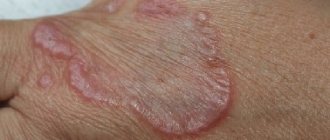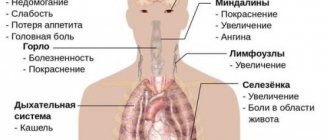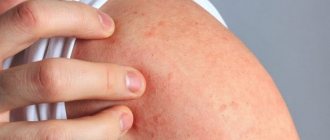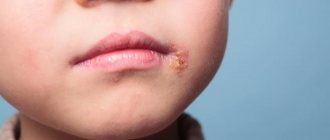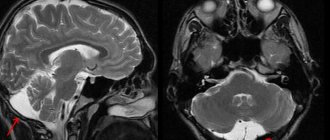How is herpes transmitted to children?
The herpes virus is very common and lives in almost all living things. It is transmitted by airborne droplets and contact . Once the herpes virus enters the body, it remains there for life. However, it can be in a “sleeping” state and not bother a person. If the herpes virus in a child has made itself felt, parents need to pay attention to this problem, because some herpes infections can take forms that are dangerous to health.
Children become infected with the herpes virus more often than adults, but overprotecting a child from infection is pointless and harmful. immunity to it . But the body is safe only in a situation where the infection is easy and without complications.
How to make an appointment with a pediatrician, dermatovenerologist, immunologist-infectious disease specialist
You can make an appointment with specialists from JSC “Medicine” (clinic of Academician Roitberg) on the website or by calling +7(495)995-00-33. The clinic is located in the Central Administrative District of the capital. If there are symptoms of herpes on the lips of a child, contact experienced specialists. For diagnostics, our clinic uses modern innovative equipment of the latest generation.
As soon as the first signs of the disease appear, do not delay visiting a doctor. Get advice from experienced doctors at JSC “Medicine” (clinic of academician Roitberg). You will be prescribed an individual course of treatment and your child will be monitored throughout it until complete recovery.
Types of disease in children
There are 80 types of herpes virus, of which 8 are dangerous to humans. The nature of the disease and the type of herpetic rash depend on the type of herpes simplex virus (HSV):
- Type 1 HSV - looks like cold-like rashes in the form of blisters on the lips, causes herpetic stomatitis and herpetic encephalitis.
- Type 2 HSV – manifests itself as a rash on the genitals (genital herpes).
- Type 3 HSV – causes chickenpox and recurrent herpes zoster.
- The 4th type of HSV - Epshane-Barr virus, causes malignant lymphoma and infectious mononucleosis - an acute viral disease with fever, damage to the respiratory tract, lymph nodes, liver, spleen and blood.
- Type 5 HSV – cytomegalovirus; affects the respiratory system, internal organs, intestines, eyes, brain, nervous and urinary systems.
- Type 6 HSV - causes viral eczema - exanthema - pseudorubella-type rash;
- The 7th and 8th types of HSV have not been sufficiently studied. Source: A.G. Lateral Herpesvirus infections in children - an urgent problem of modern clinical practice // Children's infections, 2010, No. 2, pp. 3-7
Pediatrician Mikhail Nikolsky: Herpes - to treat or not to treat
Alexandra Petrovskaya: Good afternoon. This is a program for the biggest ones. With us in the studio is pediatrician and candidate of medical sciences Mikhail Nikolsky. Mikhail Andreevich, hello.
Mikhail Nikolsky: Good afternoon.
A.P.: We have gathered here today about your scientific work on herpes types 6 and 7. Let's try to explain to the listeners what it is, and, most importantly, where these types come from, and what other types - the first, second, third and so on - go up to 6 and 7.
M.N.: In total, there are 8 or 9 types of herpes, depending on how you count. The first and second types are common herpes, which causes cold sores on the lips. The third type is the herpes zoster virus, which causes chickenpox or shingles in adults.
A.P.: So what we call chickenpox is, in fact, the same herpes?
M.N.: Not the same, it’s a completely different herpes, but also herpes.
A.P.: By what principle are they all united under this name?
M.N.: It's difficult. When scientists studied the DNA of these viruses, it turned out that they all had similar related features. The fourth type, Epstein-Barr virus, causes infectious mononucleosis. The fifth type is what everyone knows as cytomegalovirus. These are also often infections, mostly for children.
And finally, type 6 and 7 are what I do. Most often they cause roseola in children - a three-day fever or sudden exanthema. Next comes the eighth type of herpes, it occurs in Kaposi's sarcoma. This is a serious disease that predominantly occurs in HIV-infected patients.
A.P.: Besides the common name and some similarities in DNA, what else unites them? Maybe there are common methods of therapy or similar effects of the virus on the body?
M.N.: Firstly, unlike many other viruses, there is a medicine against herpes. This is what makes these viruses different from others in many ways because there are no cures for a huge number of viruses.
A.P.: What about all these fashionable antiviral drugs that are advertised everywhere?
M.N.: Everything that is advertised on TV is, unfortunately, most likely fake.
A.P.: Fakes are prohibited.
M.N.: Fakes are prohibited, but, apparently, advertising of drugs without proven effectiveness is allowed.
A.P.: This is a topic for a separate program.
M.N.: This is a problem for our country, because in our country fakes have even found their way into clinical recommendations. And we treat people with all these “bullshit drugs.” Moreover, we are obliged to treat them, because we have appropriate clinical recommendations.
A.P.: Is someone lobbying for this?
M.N.: Of course, this is lobbied for, it is paid for. And what to take if, excuse me, we have one of the members of the Russian Academy of Sciences - a homeopath.
A.P.: In these words you can feel your contempt for homeopathy.
M.N.: From the point of view of a clinical physician, to some extent, yes, contempt, this is true.
Let's return to herpes. They have a unique feature. After a person becomes ill with a primary herpes infection, these viruses do not leave the human body. All herpes that a person encounters in life remain with him forever.
A.P.: I came across the statement that it is difficult to meet a person on Earth over 10 years old who does not have antibodies to one or another type of herpes.
M.N.: And not only antibodies, but even the herpes themselves. In almost all people after a certain age, one or another herpes can be found in saliva, blood or other tissues. This is the problem with diagnosing them - doctors very often get confused. Colleagues, out of ignorance, but with the best intentions, prescribe, for example, saliva tests for frequently ill patients for the Epstein-Barr virus, cytomegalovirus, herpes type 6, type 7, and find them in the saliva. And this is the norm.
A.P.: Are they starting to treat?
M.N.: Yes, absolutely right. The patient does not know that this is the norm. He sees that he has a “terrible” test, that such and such a number of these herpes have been found, and the doctor, most likely, out of ignorance and lack of understanding of this problem, begins to treat normal carriers of herpes. And what does he treat? He treats with the same fuflomycins. And nothing happens.
A.P.: Bottom line – there is no need to treat herpes?
M.N.: It is necessary if it caused a serious illness - and all herpes in certain cases can cause serious illnesses. For example, herpes type 6 is a common cause of severe conditions in patients after a bone marrow transplant. If herpes after a bone marrow transplant has worsened against the background of a decrease, the actual destruction of one’s own immunity, then therapy necessarily requires powerful antiviral agents.
Well, take chickenpox – it would seem a harmless disease. But after 11 years it is difficult and can have consequences. Therefore, it is believed that if the patient is under 11 years of age, it often goes away on its own. And if you are over 11 years old, then it is better not to risk it, but to prescribe acyclovir.
A.P.: Is this a drug with proven effectiveness?
M.N.: Yes, it acts specifically on the chickenpox virus.
A.P.: It turns out that herpes, which is always in the body, at some point gets worse. For example, I heard about herpes type 6, that this is a typical disease for children under 2-3 years of age. It turns out that no.
M.N.: The fact is that herpes type 6 is the most common infection that always causes sudden exanthema or three-day fever or roseola. In principle, it is a very understandable infection: the child has a high fever for three days, then a typical maculopapular rash appears. Within two days it disappears on its own and the person recovers.
The infection itself can occur even through an ordinary kiss, as happens with many herpes. That is, the virus can enter the child’s body through contact with the saliva of the mother, grandmother, or any adult, who are usually the carrier of all herpes. And so the child suffers this primary infection through the human herpes virus type 6, and after that the human herpes type 6 remains in this child forever. And it won’t go anywhere, and there’s no way to get rid of it.
But it needs to be treated only in one situation - if it has caused some kind of serious illness, which almost never occurs in healthy people. Only for severe immunodeficiencies, which usually occur during organ and tissue transplantation. There are situations when intensive treatment of herpes type 6 is required.
In all other cases, there is no need to shock-treat it. And we must keep in mind that herpes is a very fashionable topic now. Herpes virus type 6 is easy to find, which means it can be presented for almost any disease as a possible diagnosis. And many doctors use this. For example: “I don’t know what’s wrong with you. Let’s look for what you definitely have.” And here is herpes type 6 - it definitely exists, and it is there.
A.P.: Another such moment. What other diseases can be associated with herpes viruses that are present in the body?
M.N.: As I already said, herpes types 6 and 7 “classically” cause roseola in children. Herpes type 6 and sometimes, but rarely, type 7 are also associated with febrile seizures in children. There are studies that show a connection between certain types of epilepsy and human herpes virus type 6. So it turns out that herpes type 6 actually causes a type of epilepsy.
A.P.: This virus is present in almost everyone’s body, but not everyone has epilepsy. That is, this suggests that there is no direct connection; there are other factors influencing the appearance of this disease?
M.N.: Of course, there are many factors here. For example, two people caught the same infection: but one had a runny nose, and the other had meningitis. But the infection is the same. Of course, there are many factors involved.
There was also a study that associated human herpes viruses 6 and 7 with other diseases, suggesting a link with multiple sclerosis. But this has not been proven. This is already a field of science, but we do not have clear indications that herpes is exactly what causes multiple sclerosis.
A.P.: During the program, we talked briefly about all herpes and outlined all the important points. And, concluding the conversation, I want to return to the beginning. What questions does science face today in this area?
M.N.: By the way, I forgot to say that a special form of human herpes type 6 is the chromosomal integrated form of this virus, when herpes type 6 is introduced into the human chromosome and begins to be inherited by all generations.
Now we have received a grant in St. Petersburg. We conduct free examinations of everyone for certain indications for the presence of chromosomally integrated human herpes type 6. It is precisely the presence of chromosomally integrated human herpes type 6 that may provide links with certain diseases. It turns out that almost 1% of the world's population has a chromosomally integrated virus built into its genome.
A.P.: Okay. Remembering my student years, what hypothesis do you have in this scientific research? If something, then what?
M.N.: We are currently recruiting a reference group, we are looking for people, we are examining them. I personally am now most interested in whether there are clinical manifestations of chromosomal integration of human herpes type 6 in newborns. In my opinion, this is the most interesting concept; no one in the world has yet developed this direction. So far there are preliminary results, but I’m not ready to announce them yet.
A.P.: Our guest was Mikhail Nikolsky, a pediatrician and candidate of medical sciences. Thank you and have a nice day everyone!
Virus activity
Most often, children are faced with the herpes simplex virus, which manifests itself in the form of that same cold on the lips.
Herpes on the lips or chickenpox are not as dangerous for a child as herpetic lesions of the eyes, genitals, and internal organs.
Externally, herpes appears as a rash on the skin or mucous membranes. It usually looks like small blisters that eventually burst and become sores. In addition to the rash, there is burning and itching.
How often the herpes virus is activated is influenced by hereditary predisposition and the state of the immune system. The weaker the child’s immunity, the more susceptible he is to virus attacks.
Newborns up to 1 year of age are protected by maternal antibodies. The peak incidence is observed at the age of 2-3 years. By the age of 15, up to 90% of adolescents are infected with HSV. The pathogen is in an inactive state in the body and does not cause discomfort. Under unfavorable conditions, HSV is activated. Source: A. Taieb, N. Diris, F. Boralevu, C. Labreze Herpes simplex in children. Clinical manifestations, diagnostic value of clinical signs, clinical course // Ann Dermatol Venerol, 2002, v.129, No. 4, p.603—608
Causes of exacerbations and relapses of herpes in children:
- decreased immunity due to severe and prolonged illnesses;
- severe shocks and chronic stress;
- systematic fatigue;
- hypothermia;
- taking hormonal medications;
- endocrine pathologies;
- hormonal changes in adolescence;
- systematic unbalanced diet;
- complicated seasonal colds;
- chemical and radiation anticancer therapy;
- excessive physical activity. Source: M.N. Kankasova, O.G. Mokhova, O.S. Pozdeeva Frequently ill children: the view of an infectious disease specialist // Practical Medicine, 2014, No. 9(85), pp. 67-71
Development of infection
A decrease in the child’s immunity for various reasons contributes to the occurrence of herpes, for example, caused by factors such as emotional and physiological stress, exacerbation of chronic and the appearance of acute diseases. In addition, children under 3 years of age have a physiologically weakened immune system, and therefore are especially susceptible to contracting a herpes infection. The first appearance of symptoms of a herpes infection is possible against the background of a developing or passing cold. And if herpes has settled in the body, then its activity can manifest itself in the presence of other diseases, for example, acute respiratory viral infections, which significantly suppress the immune response.
Treatment of herpes in children
It is impossible to eliminate the herpes virus from the body, so the goal of treatment is to reduce its activity , eliminate symptoms by activating the immune system, achieve stable remission and prevent complications.
The most effective medicine against most manifestations of the herpes virus in children is the substance acyclovir. Treatment uses both oral and local medications. Source: I.F. Barinsky, L.M. Alimbarova, A.A. Lazarenko, F.R. Makhmudov, O.V. Sergeev Vaccines as a means of specific immunocorrection for herpetic infections // Questions of Virology, 2014, pp. 5-11
A comprehensive treatment regimen for acute herpetic infection includes:
- antiviral-antiherpetic drugs - tablets, injections and ointments - based on acyclovir;
- surface antiseptics for the prevention of secondary bacterial infections;
- immune stimulants – herbal and interferon derivatives;
- multivitamins and vitamins in therapeutic doses;
- antipruritic antihistamines;
- antipyretics;
- hepatoprotectors – in case of severe intoxication;
- diet therapy with sufficient amounts of protein and exclusion of foods that are sources of arginine.
In severe general condition, bed rest is recommended. Only a doctor can decide how to treat herpes in a child.
Diagnostics
During your initial visit, you can visit a pediatrician or dermatovenerologist. However, if the disease often recurs, you should be examined by an infectious disease immunologist. He will make a qualified conclusion after all diagnostic measures. If the diagnosis is confirmed, antiviral drugs and immunostimulants are prescribed. The course of the disease is monitored by a specialist without fail. He will monitor whether positive changes have occurred. Periodic observations with a doctor will help keep the situation under control. Parents should not do this on their own. The child needs to undergo regular examinations for changes in well-being. In addition, after the first diagnosis, doctors will advise how to choose the baby’s diet and prescribe other measures that can improve the child’s condition. You can get diagnosed by an immunologist as soon as the first symptoms of an unpleasant illness appear. It is better to prevent the disease than to deal with its consequences and complications, especially since it is impossible to remove this virus from the body.
Possible complications
Without timely and adequate treatment, herpes infection can cause severe complications:
- disruption of internal organs;
- eye diseases;
- deafness;
- sore throat;
- nervous and mental disorders;
- infertility.
Sources:
- A.G. Side. Herpesvirus infections in children - an urgent problem of modern clinical practice // Children's infections, 2010, No. 2, pp. 3-7.
- Taieb, N. Diris, F. Boralevu, C. Labreze. Herpes simplex in children. Clinical manifestations, diagnostic value of clinical signs, clinical course // Ann Dermatol Venerol, 2002, v.129, No. 4, p.603-608.
- M.N. Kankasova, O.G. Mokhova, O.S. Pozdeeva. Frequently ill children: the view of an infectious disease specialist // Practical Medicine, 2014, No. 9(85), pp. 67-71.
- I.F. Barinsky, L.M. Alimbarova, A.A. Lazarenko, F.R. Makhmudov, O.V. Sergeev. Vaccines as a means of specific immunocorrection for herpes infections // Questions of Virology, 2014, pp. 5-11.
The information in this article is provided for reference purposes and does not replace advice from a qualified professional. Don't self-medicate! At the first signs of illness, you should consult a doctor.
Clinical manifestations
Stomatitis in children is characterized by a gradual onset of the disease. Clinical signs of the disease do not appear immediately after infection. The incubation period is typical for this pathology; it lasts from two days to three weeks.
Symptoms of herpetic stomatitis in children appear starting from the prodromal period.
Each period has its own clinic:
- Latent – lasts up to two weeks. The child's sleep is disturbed and he refuses to eat. The baby becomes restless and whiny. He has increased salivation, possible nausea and vomiting. The lymph nodes are enlarged and painful on palpation.
- The height of the disease - at this time rashes appear on the skin and mucous membranes. They are located on the soft, hard palate, gums, cheeks, lips and tongue. They are group or single, up to three millimeters in size. They are thin-walled bubbles filled with a clear liquid. Their formation lasts up to four days. The vesicles quickly open, then erosions and painful aphthae form. They are shallow ulcers covered with a white coating. The mucous membrane in the mouth is swollen and bleeding. The child develops a high temperature of up to 40 degrees. A runny nose, cough, and conjunctivitis occur.
- Fading - aphthae, erosions gradually heal and epithelialize. These formations heal without scarring. Often there is a wavy course of the disease. The periods of appearance of rashes alternate with rises in temperature.
The illness usually lasts up to two weeks. In children under one year of age, generalization of the process is possible. The development of sepsis, damage to all internal organs and meninges is likely.
Prices
| Name of service (price list incomplete) | Price |
| Appointment (examination, consultation) with a dermatovenerologist, primary, therapeutic and diagnostic, outpatient | 1750 rub. |
| Consultation (interpretation) with analyzes from third parties | 2250 rub. |
| Prescription of treatment regimen (for up to 1 month) | 1800 rub. |
| Prescription of treatment regimen (for a period of 1 month) | 2700 rub. |
| Consultation with a candidate of medical sciences | 2500 rub. |
| Dermatoscopy 1 element | 700 rub. |
| Setting up functional tests | 190 rub. |
| Excision/removal of cutaneous/subcutaneous elements and formations (1 element) | 2550 rub. |
| Removal of milia of one unit using electrocoagulation | 350 rub. |

